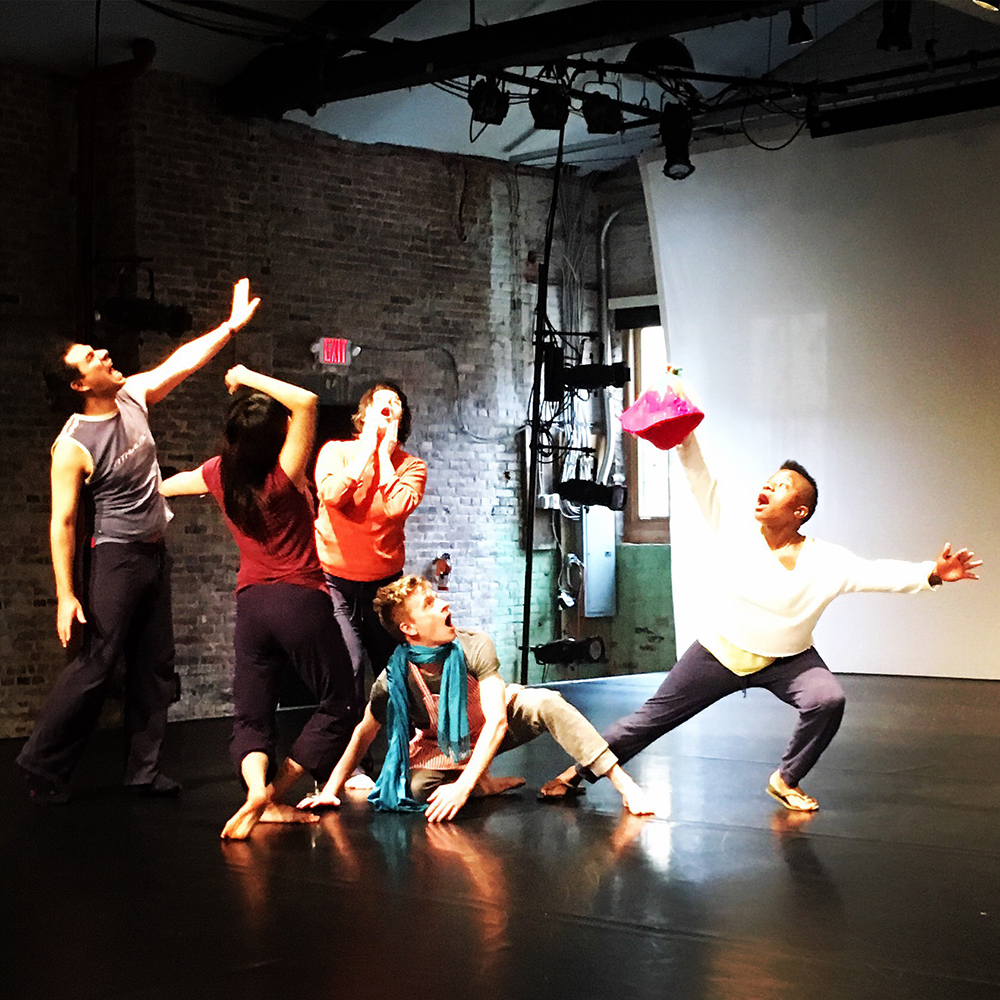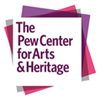NOVEMBER WORKSHOP
We began working with oral historian Suzanne Snider. Suzanne instructed the dancers methods of conducting interviews, and the philosophy of oral history work so that they could weave aspects of this practice into the research. Suzanne then familiarized the dancers with the theoretical underpinnings of the work as well as methodology, to support their exploration in terms of interviewing but also in terms of making connections between different forms of narrative. We discussed ideas from the field such as “reciprocity,” “shared authority,” and “collective memory,” while also focusing on ways to put an interviewee at ease. Karinne was also present for this workshop. Photos taken at The Whole Shebang by Stephen Metzger.
Oral History interview training with Suzanne Snider
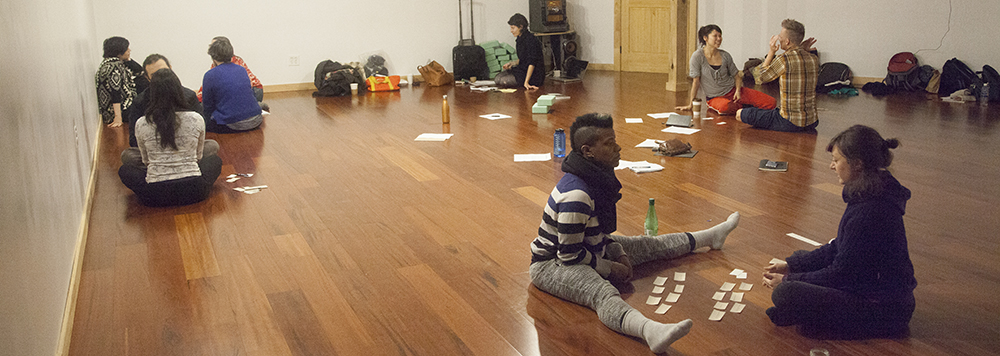 dancers break into groups to do interview exercises
dancers break into groups to do interview exercises
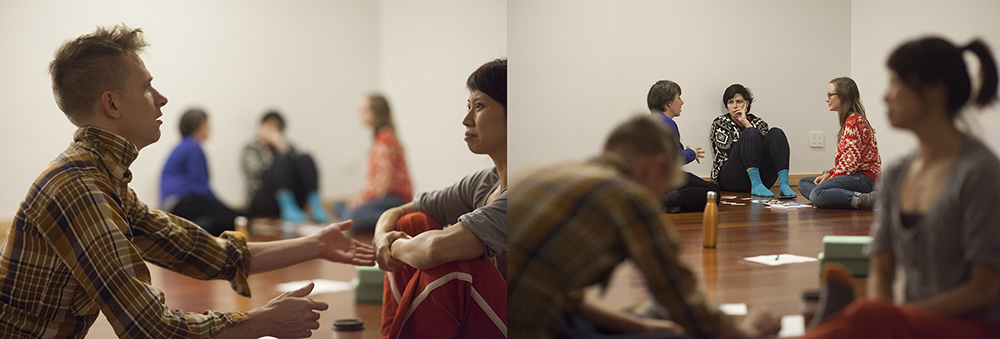 Scott McPheeters and Eun Jung Choi (in foreground) practicing interview strategies and listening exercises
Scott McPheeters and Eun Jung Choi (in foreground) practicing interview strategies and listening exercises
 Dancers discuss the difference between an “open question” and a “closed question” L: Suzanne Snider, M: Helen Hale and Jennifer Kidwell, R: Nichole Canuso
Dancers discuss the difference between an “open question” and a “closed question” L: Suzanne Snider, M: Helen Hale and Jennifer Kidwell, R: Nichole Canuso
After this period of work with Suzanne the dancers and I transferred some of the philosophy and methods behind the oral history work into movement scores. In one exercise we translated the roles of interviewer, narrator and witness into physical modes of attention and action. Some things we discussed – how does silence translate? It doesn’t have to be stillness. There is kinetic silence. – What is the difference between open questions and listening in this physical structure. Can listening include “joining” in this context? We decided yes. – In this context the narrator is not recalling a past event or telling a “story”, they are instead navigating the present and accepting the listener into the sphere of their narrative. – The interviewer is providing the conditions for the narrator to discover the next thing. We worked on scores of empathy and embodiment. What does it mean to voice for the body of someone else. Exploring both the generosity and the oppression inherent in the act. Also found humor when both work together to find a guiding force that is somewhere between the two.
Tranferring Oral History concepts into movement scores
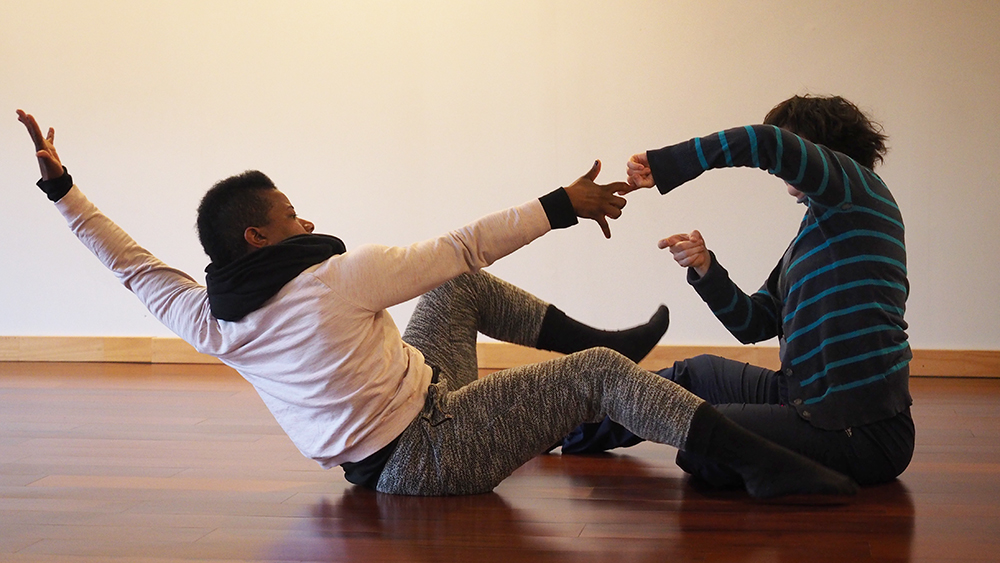 Jennifer Kidwell and Meg Foley performing the exercise One Body / One Voice
Jennifer Kidwell and Meg Foley performing the exercise One Body / One Voice
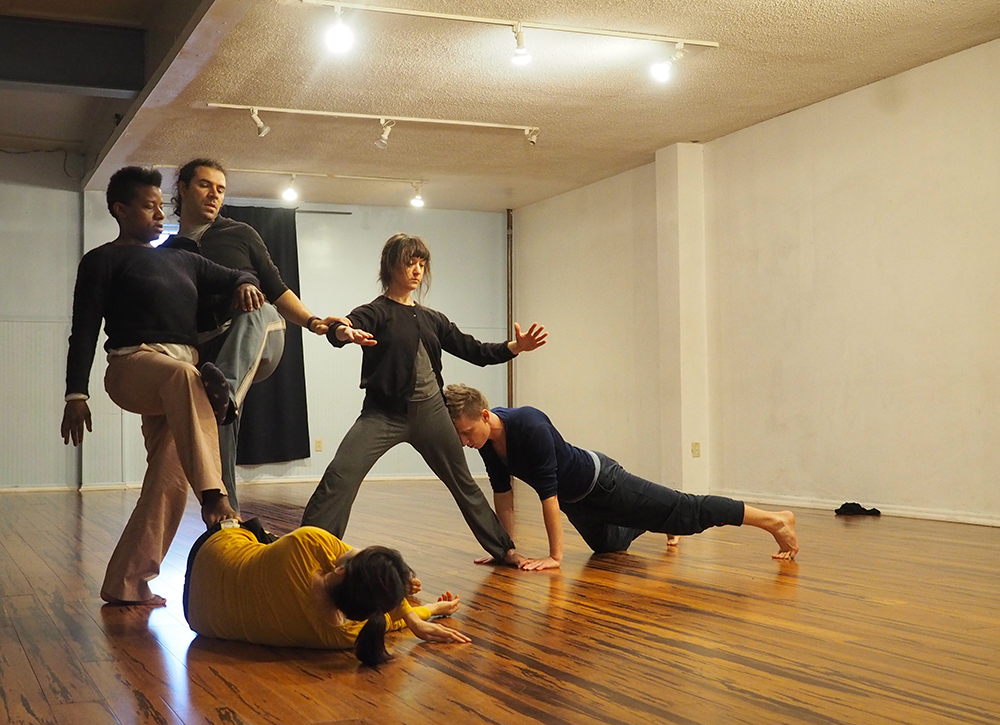 L-R: Jennifer Kidwell, Eun Jung Choi, Guillermo Ortega, Helen Hale, Scott McPheeters performing The Octopus of Sensation exercise
L-R: Jennifer Kidwell, Eun Jung Choi, Guillermo Ortega, Helen Hale, Scott McPheeters performing The Octopus of Sensation exercise

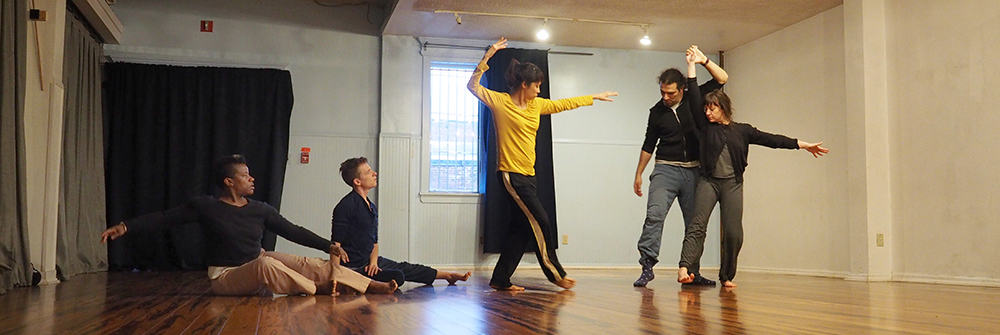 L-R: Jennifer Kidwell, Scott McPheeters, Eun Jung Choi, Guillermo Ortega, Helen Hale
L-R: Jennifer Kidwell, Scott McPheeters, Eun Jung Choi, Guillermo Ortega, Helen Hale
JANUARY INTENSIVE (RESONATING IN THE CONTINUOUS PRESENT)
The focus of the first two weeks of January was on vocal work with visiting artist Jean-Rene Toussaint. Interspersed with those workshops were sessions with Karinne and me exploring language, movement, and improvisational interview structures. We put aside the recording devices used in the oral history work for this 2 week intensive.
Vocal workshops with Jean-Rene Toussaint
 Jennifer Kidwell and Jean-Rene Toussaint exploring voices
Jennifer Kidwell and Jean-Rene Toussaint exploring voices
 Nichole Canuso and Meg Foley (orange shirt) performing a Question and Answer exercise using sound and body without words
Nichole Canuso and Meg Foley (orange shirt) performing a Question and Answer exercise using sound and body without words
Jean-Rene placed a great deal of emphasis on listening. Our voices travel through other bodies and return to us, delivering information about others and reflections of ourselves. We embraced listening as more important than expressing. “The more we are listening the more we understand the starting point of our own speaking.”… This sentiment resonates with much of the philosophy behind the oral history training. We explored the difference between the social voice, the primal voice and the internal voice, working alone, in pairs and as a group.
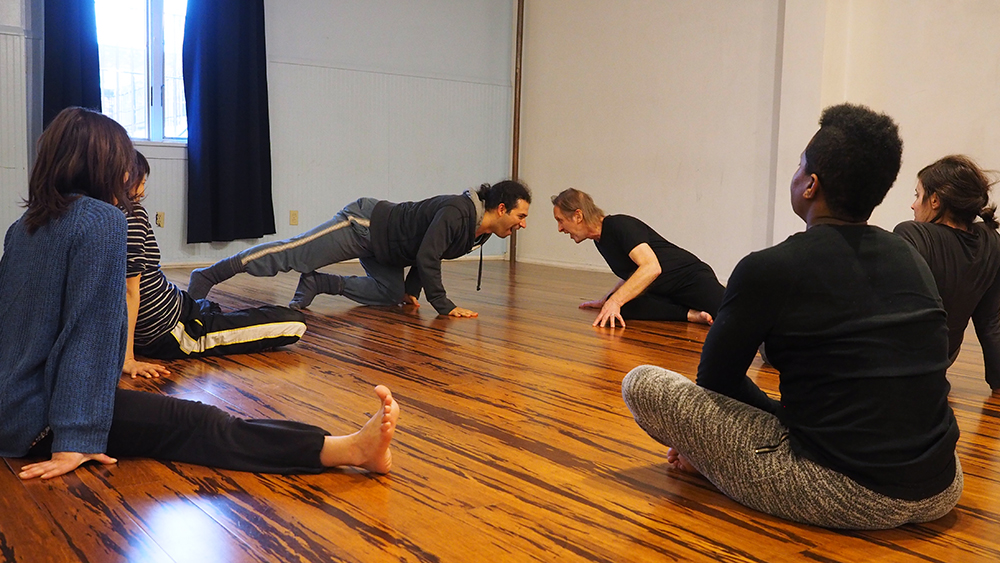 Guillermo Ortega and Jean-Rene Toussaint performing a sound exercise balancing the inhale of one partner with the exhale of the other
Guillermo Ortega and Jean-Rene Toussaint performing a sound exercise balancing the inhale of one partner with the exhale of the other
 Nichole Canuso, Jennifer Kidwell, and Meg Foley use physical pressure to support the intensity of one person’s struggle to rise and sound
Nichole Canuso, Jennifer Kidwell, and Meg Foley use physical pressure to support the intensity of one person’s struggle to rise and sound
With Karinne we talked about the difference between plot, wild time, and the continuous present. We did some reading from Gertrude Stein’s Tender Buttons observing the economy of her sentences, packed with energy. We practiced seeing and describing without the violence of “naming” things. We then returned to the empathy/embodiment work from November exploring a wider lens on descriptions and use of language. We began drawing maps from memory and using those as guides for writing stories that collide truth and fiction. Colliding memories, inventing fiction and balancing the focus on content and form.
Creative writing workshops with Karinne Keithley Syers
 L-R: Karinne Keithley Syers, Scott McPheeters, Nichole Canuso, Eun Jung Choi, Helen Hale performing a creative writing exercise led by Karinne Snider
L-R: Karinne Keithley Syers, Scott McPheeters, Nichole Canuso, Eun Jung Choi, Helen Hale performing a creative writing exercise led by Karinne Snider
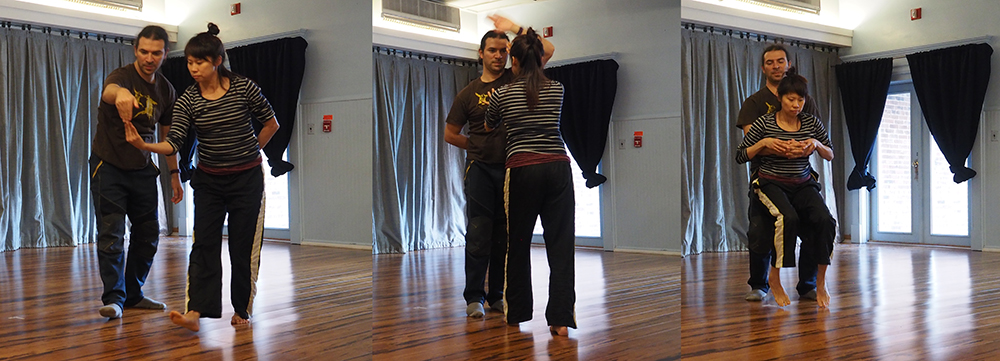 Guillermo Ortega and Eun Jung Choi create a movement duet for the others to use as visual field for the other dancers to work on “seeing and naming”
Guillermo Ortega and Eun Jung Choi create a movement duet for the others to use as visual field for the other dancers to work on “seeing and naming”
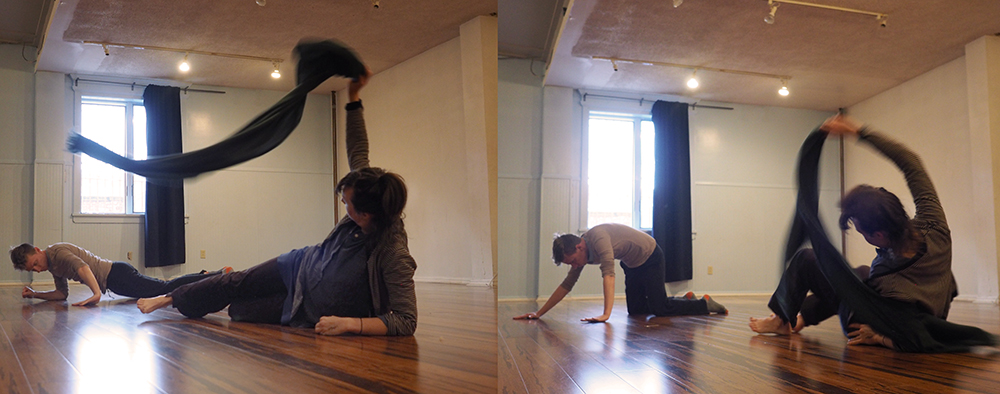 Scott McPheeters and Helen Hale create a movement duet for the others to use as visual field for the other dancers to work on “seeing and naming”
Scott McPheeters and Helen Hale create a movement duet for the others to use as visual field for the other dancers to work on “seeing and naming”
Also in January the dancers and I explored a structure we’re calling Loop of We – an attempt at physical and emotional unison. An impossible task that is alight with the energy of the attempt.
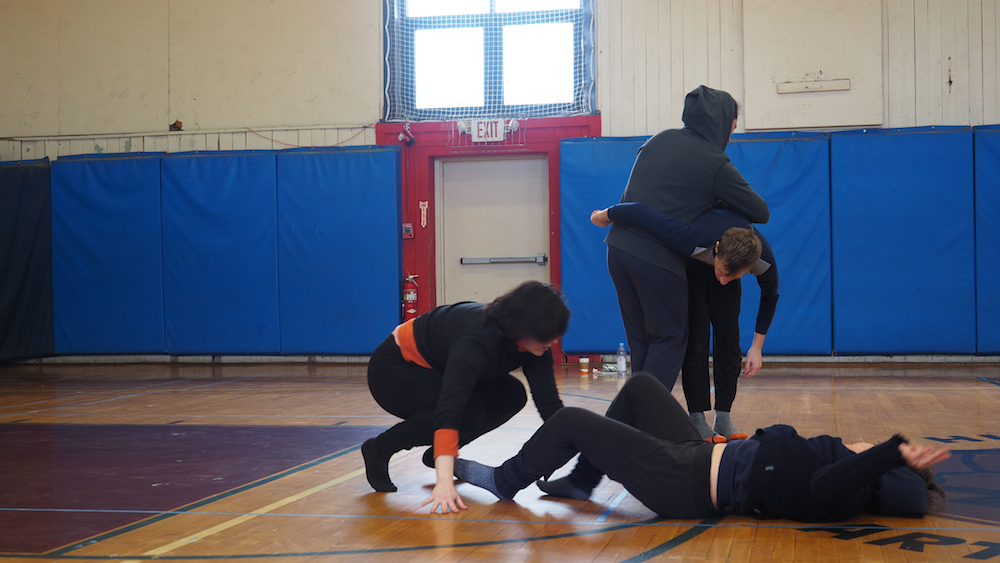
HUDSON RETREAT
During this week long retreat the full team worked together to combine these areas of inquiry. We recorded 40 minute oral history interviews with each of the 6 performers. These interviews were preceded by the creation of visual maps which became instrumental in interview processes. Both the interviews and the maps fed subsequent movement scores and creative writing exercises. Interspersed with these focused experiments were shared meals, long walks and late night chats during which the information marinated, echoed, deepened.
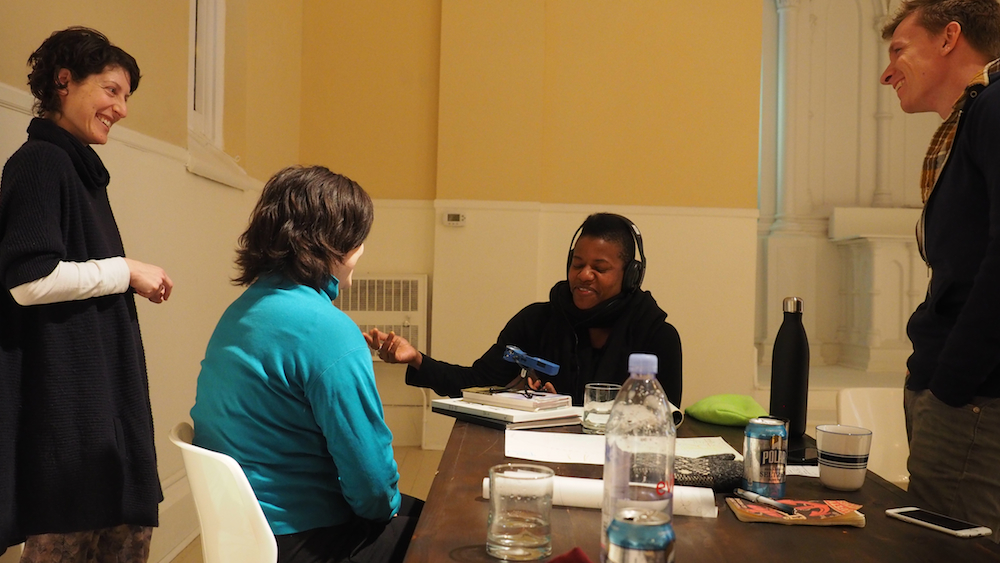 L-R: Suzanne Snider, Meg Foley, Jennifer Kidwell, Scott McPheeters. Meg volunteered to be interviewed by Jennifer as the rest of the group witnessed. The interview was recorded and portions of the audio were used in the final showing during Interview Structure
L-R: Suzanne Snider, Meg Foley, Jennifer Kidwell, Scott McPheeters. Meg volunteered to be interviewed by Jennifer as the rest of the group witnessed. The interview was recorded and portions of the audio were used in the final showing during Interview Structure
This was the first time Suzanne, Karinne and I were all in a co-leadership mode, allowing us to find overlap in our curiosities. For instance the dancers and I shared our physical interview structures, inviting Suzanne and Karinne to witness and get involved in this research. Karinne was interested in helping us find language to continue to help us transfer the ideas of Oral History interviews to the body. For example “affordance”; Affording your partner a situation, the way a chair affords one to sit.
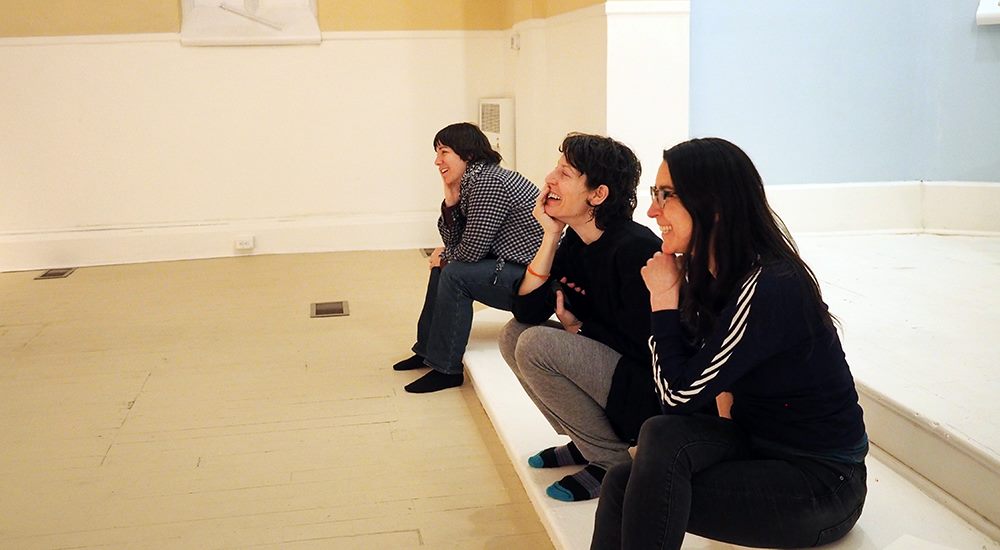 L-R: Karinne Keithley Syers, Suzanne Snider and Nichole Canuso watch as dancers perform an improvisational exercise based on the interview process
L-R: Karinne Keithley Syers, Suzanne Snider and Nichole Canuso watch as dancers perform an improvisational exercise based on the interview process
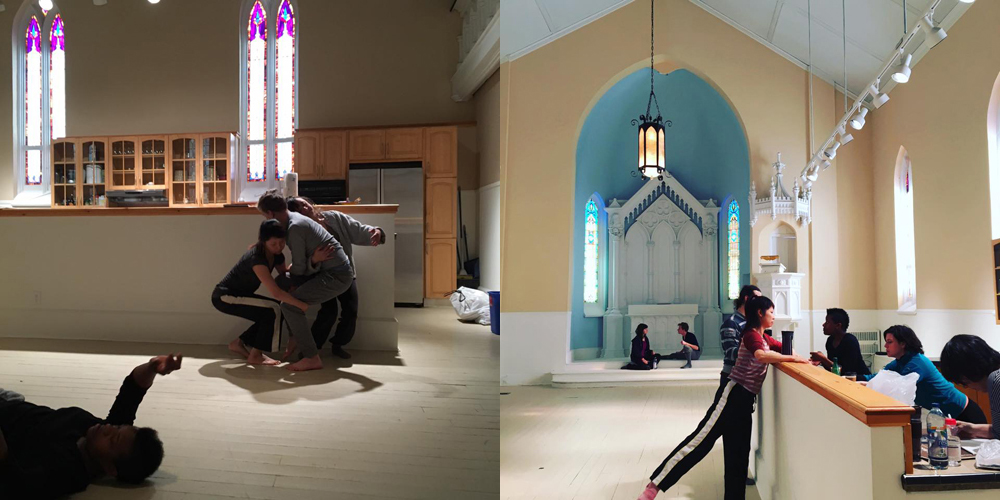
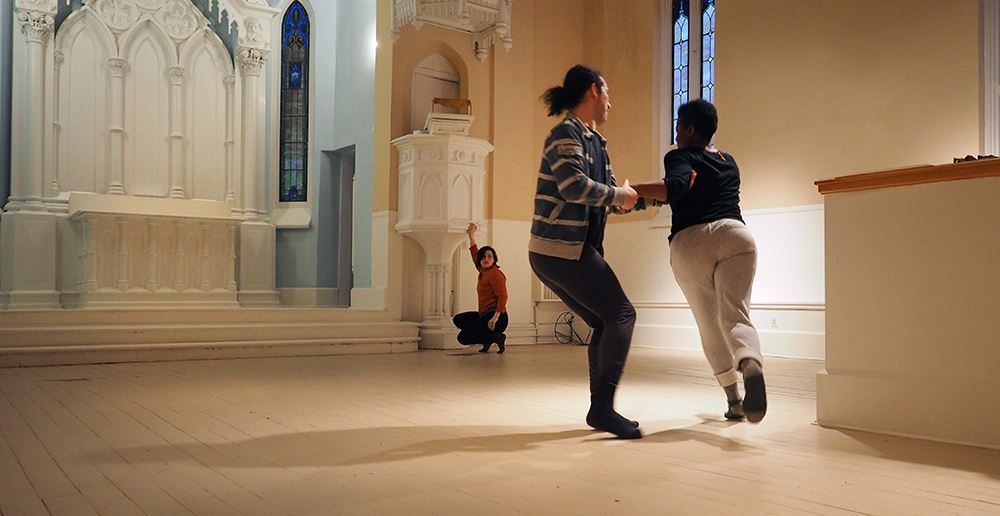 L-R: Meg Foley, Guillermo Ortega, Jennifer Kidwell performing an improvisational exercise translating their roles as interviewer, narrator, and witness into a physical score, while the audio recording of their interview plays over the sound system
L-R: Meg Foley, Guillermo Ortega, Jennifer Kidwell performing an improvisational exercise translating their roles as interviewer, narrator, and witness into a physical score, while the audio recording of their interview plays over the sound system
MAPS
Mapping memory, spaces, sensations, fears, expectations. As a group we listed categories that could be useful: (Scenes of Education; Scenes of Relationship; Brushes with Death; Kinds of Kisses; Beginnings/Births; Endings/Deaths; Transformations; moments of solitude) Then alone, we each chose one of these categories to map out on our own large piece of paper. Using words, names, images, lines we each mapped our memories through the filter of that one category, using a single colored pencil. We then chose a different colored pencil to draw the next category allowing the two maps to intermingle and overlap on the page; inviting time and geography to reorganize themselves. Eventually we each had a personal map with four colored filters intermingling on the page. A houseplant in Berkley nestles beside a hill in Japan; the ache of solitude in Massachusetts hovers above the devastation of a car wreck on the B/Q/E; dirty dishes from Italy are scattered along train tracks in Vermont; Wall paper in Maine overlays a college campus in Pennsylvania; an orange road filled with traffic connects the meeting place of two lovers and the birth of a boy. Each map was unique, not just in color and content but in style: Some maps were delicately drawn, some chaotic and circular, some abstract and suggestive and others meticulously detailed. We each dove deeply into our own solo explorations of memory before then interviewing one another. The maps allowed us to ponder and provoke.
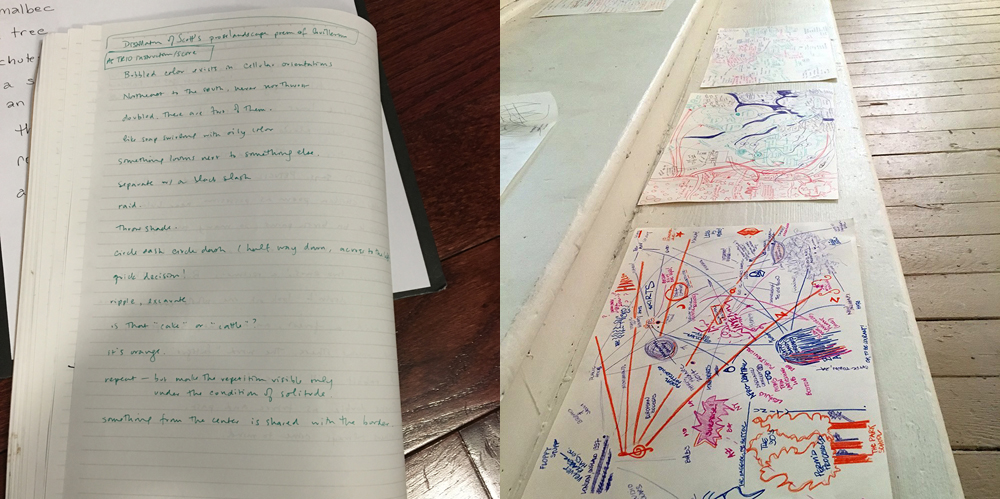
These maps became the springboard for explorations (physical, verbal and written) throughout retreat and forward into the rest of the research period.
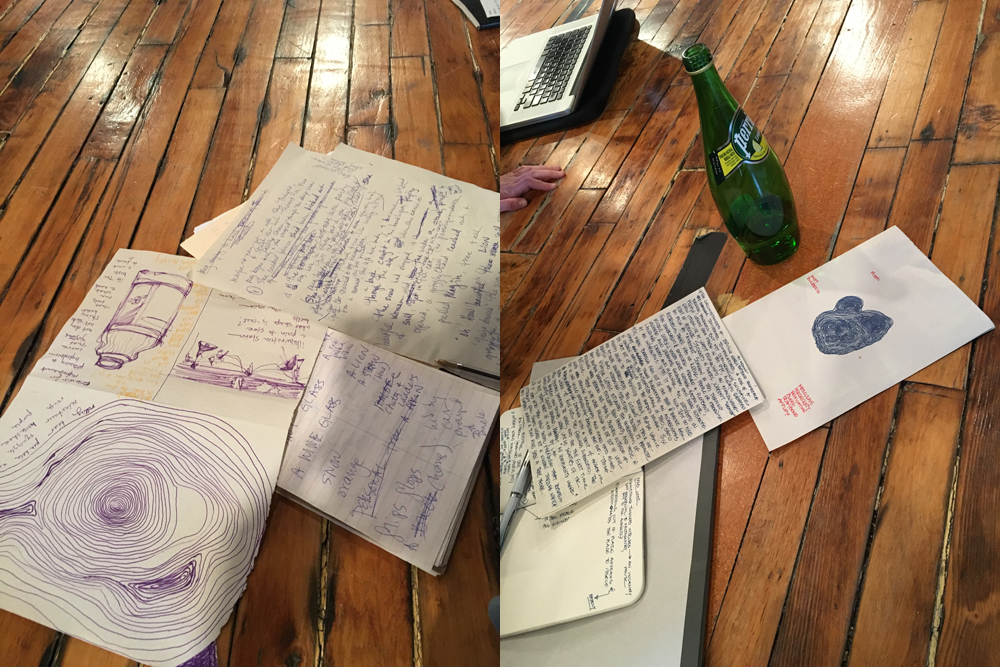
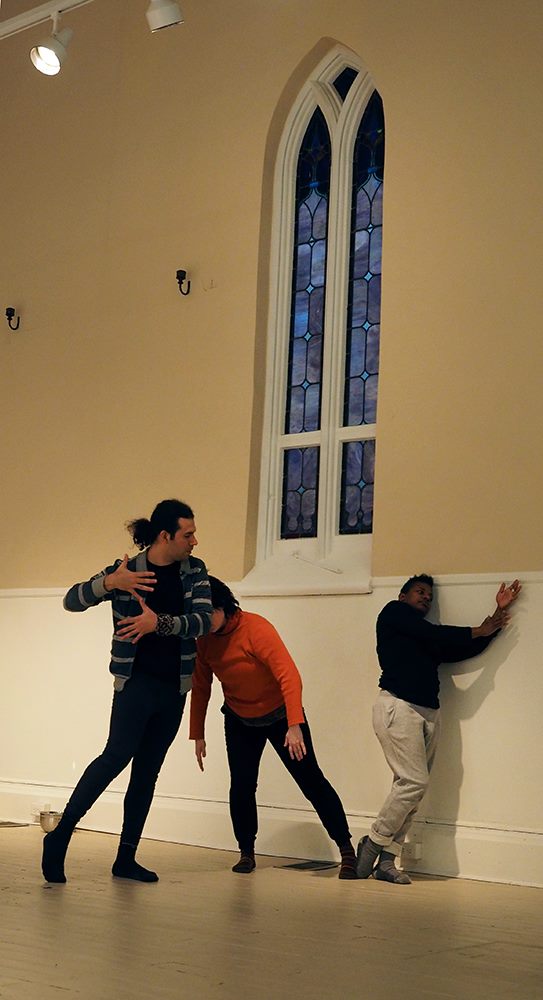 L-R: Guillermo Ortega, Jennifer Kidwell, Meg Foley performing an improvisational exercise translating their roles as interviewer, narrator, and witness into a physical score, while the audio recording of their interview plays over the sound system
L-R: Guillermo Ortega, Jennifer Kidwell, Meg Foley performing an improvisational exercise translating their roles as interviewer, narrator, and witness into a physical score, while the audio recording of their interview plays over the sound system
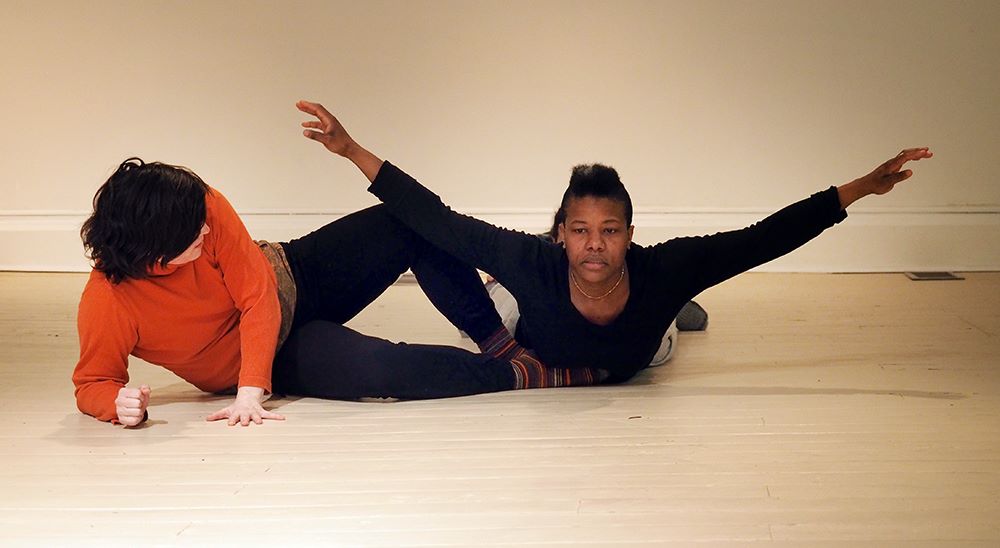 Meg Foley and Jennifer Kidwell during retreat in Hudson, NY
Meg Foley and Jennifer Kidwell during retreat in Hudson, NY
NYC WORKSHOP
A few weeks after the Hudson Retreat, I met up with Karinne to focus on editing the interviews. We spend a few days at the computer listening through all the interviews and exploring the possibility of creating an aural score that could co-inside with a physical score. It was a painful process to alter the purity of the long-form interviews, but it felt like an essential inquiry: How (if at all) can these conversations be repurposed and reframed for performance. A few of the dancers met up with us in a studio New York to test some of these new recordings.
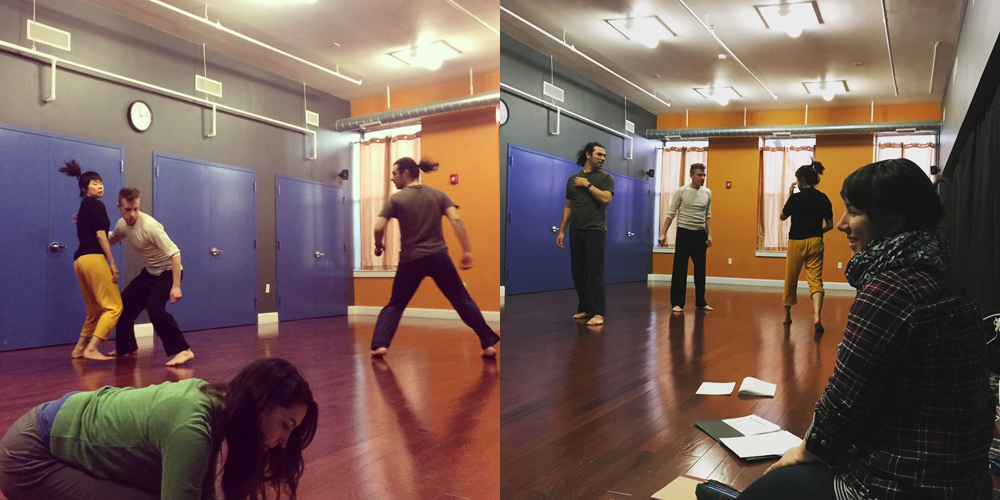 dancers Eun Jung Choi, Scott McPheeters, and Guillermo Ortega perform to newly edited recordings of oral history interviews, and Nichole Canuso (left) and Karinne Keithley Syers (right) observe and take notes
dancers Eun Jung Choi, Scott McPheeters, and Guillermo Ortega perform to newly edited recordings of oral history interviews, and Nichole Canuso (left) and Karinne Keithley Syers (right) observe and take notes
MARCH WORKSHOP
Accumulating. Layering. Embracing Abundance before essentializing. Throughout the month of March the performers and I continued our research and prepared to share aspects of the work with an invited audience. Knowing there is a showing approaching can alter a process in ways that reduce exploration and promote editing and polishing. We worked to resist those urges and instead find ways of framing our questions and carving windows into our ongoing exploration for an audience to peer through. It is a luxury to know (and trust) that we are on a road that is long. The type of exploring we did would not have been possible if the endpoint was fixed, if the showing were meant to be a draft of a performance.
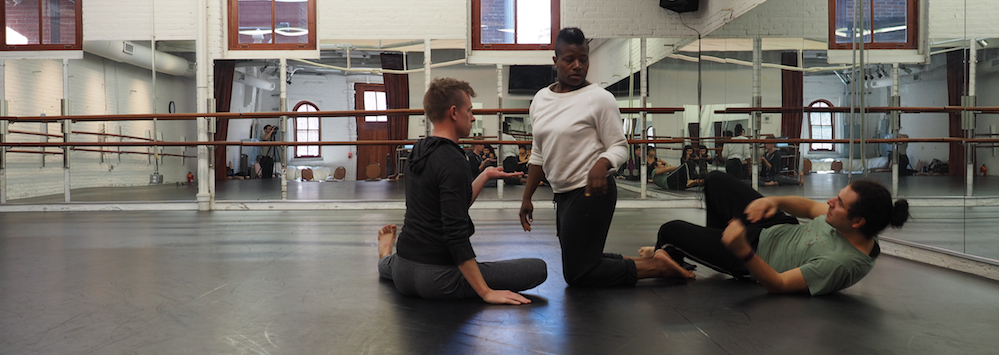 L-R: Scott McPheeters, Jennifer Kidwell, Guillermo Ortega
L-R: Scott McPheeters, Jennifer Kidwell, Guillermo Ortega
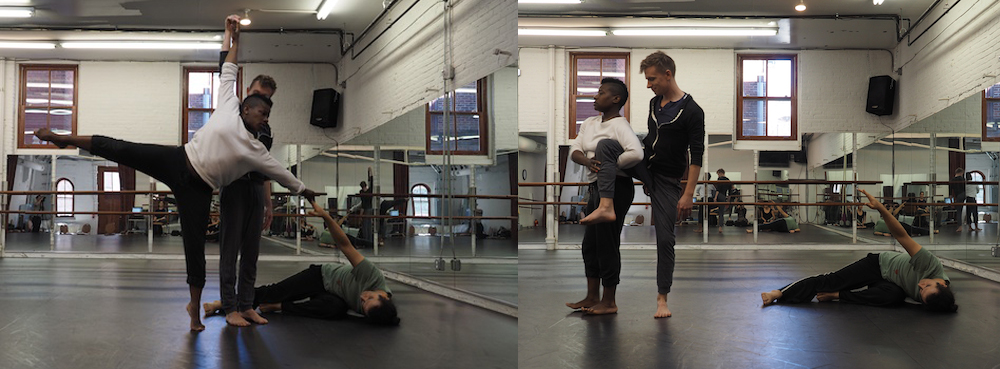
 L-R, Helen Hale, Jennifer Kidwell, Eun Jung Choi
L-R, Helen Hale, Jennifer Kidwell, Eun Jung Choi
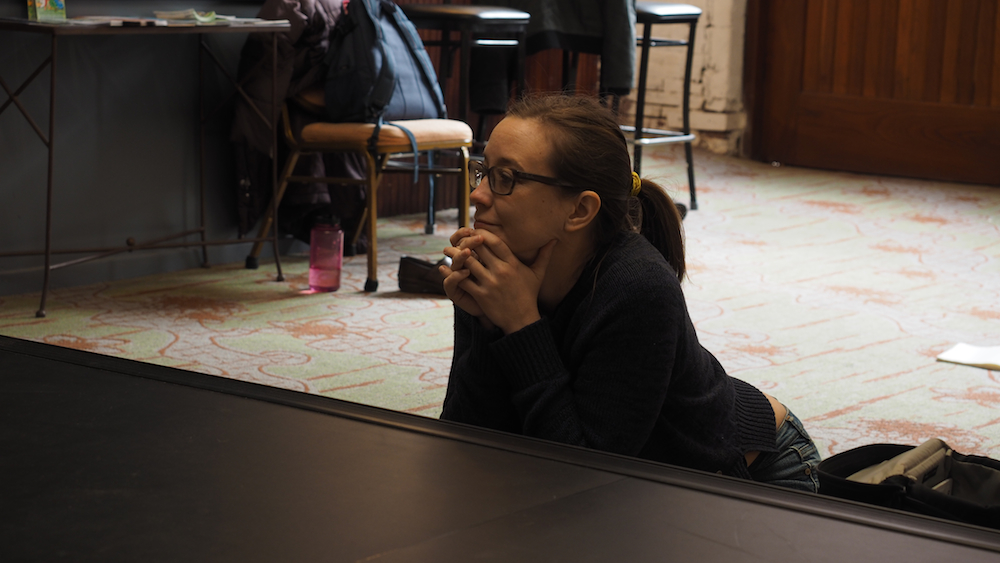 Ellen Chenoweth observes
Ellen Chenoweth observes
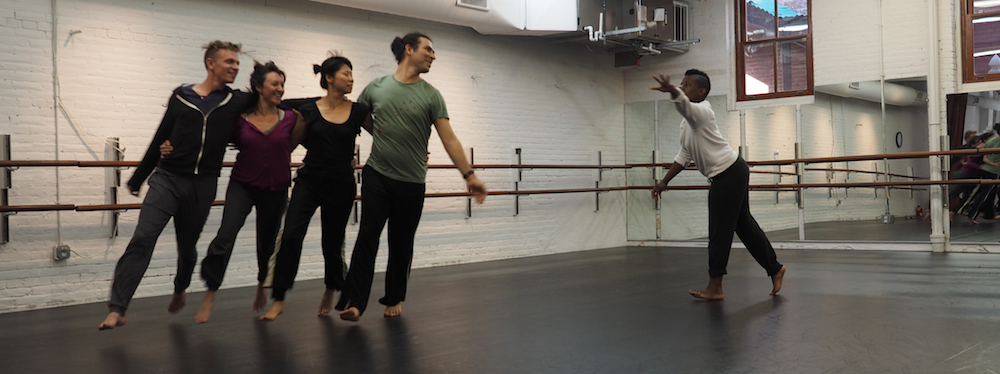 L-R: Scott McPheeters, Helen Hale, Eun Jung Choi, Guillermo Ortega, Jennifer Kidwell rehearsing for the showing
L-R: Scott McPheeters, Helen Hale, Eun Jung Choi, Guillermo Ortega, Jennifer Kidwell rehearsing for the showing
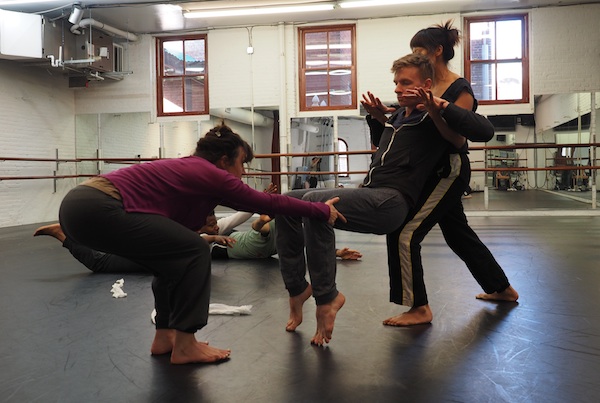 L-R: Meg Foley, Scott McPheeters, Eun Jung Choi in foreground
L-R: Meg Foley, Scott McPheeters, Eun Jung Choi in foreground
 L-R, Jennifer Kidwell, Eun Jung Choi, Guillermo Ortega, Scott McPheeters
L-R, Jennifer Kidwell, Eun Jung Choi, Guillermo Ortega, Scott McPheeters
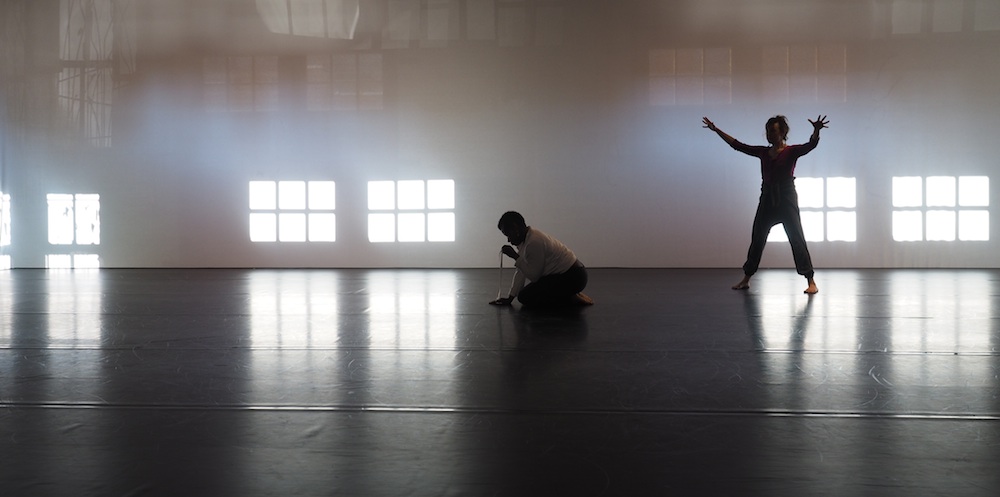
SHOWING
on March 31st we held an invited showing at the Performance Garage. We shared a range of performance excerpts, offering a short introduction of process before each one.
